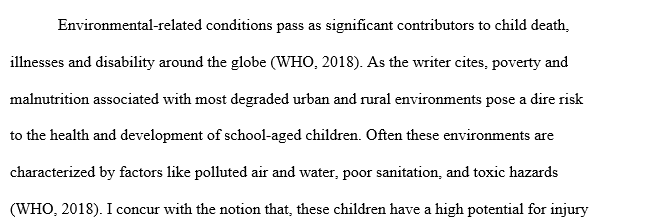Safety and health are essential to all children. According to the textbook,
Safety and health are essential to all children. According to the textbook, Physical Examination and Health Assessment, the following are all normal findings in school-aged children: Gross motor skills (runs, jumps, climbs, rides bicycle, general coordination), fine motor skills (ties shoelace, uses scissors, writes name and numbers, draws pictures), and language skills (vocabulary, verbal ability, able to tell time, reading level). However, there are environmental factors the predispose school-aged children to illness, injury, and death, especially when linked to poverty. Children from poor families or neighborhoods are more likely than other children to have serious health problems.
According to 2014 Census data, an estimated 21.1% of all US children younger than 18 years (15.5 million) lived in households designated as “poor” (Pediatrics). Poverty can lead to adverse health outcomes in childhood affecting physical health, socioemotional development, and educational achievement. Examples of this include language development, chronic illness, environmental exposure, nutrition, and injury. Here are correlations between environmental and health issues in the school-aged child:
1. Poor children are less likely to participate in organized activities and often do not have enough supplies or books at home. This affects both the socioemotional development and educational level of the school-aged child.
2. Being poor is stressful. It causes damage to the brain and to a child’s overall physical and mental health into adulthood (Healthychildren.org).
3. Unsafe homes that may causes injuries from cracked flooring and stairs, improper sanitation, exposure to heat because of no air conditioning, and lead poison from outdated paint on walls.
4. Falls from improper community playgrounds because the community is unable to pay for the costs to repair unsafe equipment.
5. Injuries to the child’s head from bicycle injuries where parents are unable to pay for helmets.
6. Nutrition deficits because parents are unable to buy adequate food with nutritious benefits.
7. Gun violence and deaths that are so prevalent in poor communities. School-aged children are injured or killed from accidental gunshots by the child or instances where the child is shot in the crossfire of gang shootings. According to Gun Violence Achieve, there have been 7,876 child deaths in 2018 so far.
Some ways to help school-aged children at risk for injuries and illness include:
1. Supplemental Nutrition Program for Women, Infants, and Children (WIC) is a program that provides community families with nutrition education and growth monitoring.
2. The National School Lunch Program is a federally funded program that provides low-cost and free breakfasts, lunches, and, on a limited basis, summer food to school-aged children (Pediatrics). These meals are produced by Dietary Guidelines of American and can help the nutritious value in children that otherwise can’t afford adequate food.
3. Medicaid and the Children’s Health Insurance Program (CHIP). This came from the Affordable Care Act and now allows children access to medical attention to help children with injuries or medical conditions they were able to get in past years.
By bringing an awareness and understanding of the effects of poverty on children, pediatricians and other healthcare partners can help family members of the community assess links to resources and coordinate care with community partners.
References
Gun Violence Achieve (2018). Retrieved from: http://www.
Healthy Children. Poverty and Child Health. Retrieved from:
https://www.healthychildren.
